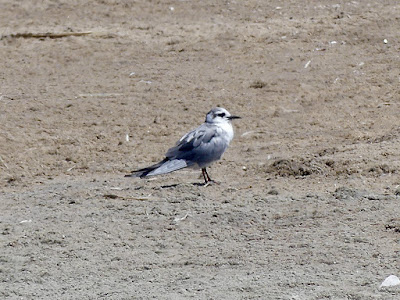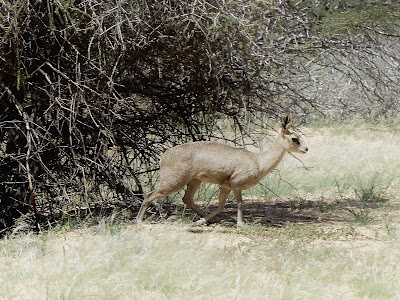Part 3. Etosha National Park - Kunene River Lodge - Windhoek
In all we spent 5 nights in Etosha NP. Two at Okaukeujo Camp in the middle, two at Namutoni Camp in the east and one at Dolomite Camp in the west. Rain had been threatening for a few days and it finally arrived during our stay at Namutoni. Fortunately it only rained in the evenings and we were able to explore much of the park. We managed to see Lion, Black Rhinoceros, Elephant, Giraffe, Greater Kudu, Cheetah and over 150 bird species.
 |
| Part of an estimated 5000 Abdim's Storks gathering at a waterhole. |
 |
| An unusually marked Zebra. |
 |
| Sociable Weaver |
 |
| South African Ground Squirrel |
 |
| Red-crested Korhaan |
 |
| Wildebeest |
 |
| Northern Black Korhaan |
 |
| Springbuck |
 |
| Lion looking at a potential meal. |
 |
| Rufous-eared Warbler |
 |
| Spike-heeled Lark |
 |
| (Black-faced) Impala |
 |
| Cape Crow |
 |
| European Bee-eater |
The park was not crowded but a pride of lions did cause a minor traffic jam. Recent rain meant that all the birds were breeding and had on their finest plumage. We delighted in the fine Whydahs and Bishops as well as the many Bee-eaters and Rollers. We found two locations where thousands of Red-billed Quelea pairs were nesting. The rain also meant a nice assortment of water birds were present and this boosted the species tally.
 |
| Double-banded Courser |
 |
| Black Rhinoceros |
 |
| Pale Chanting-Goshawk with breakfast. |
 |
| Lion |
 |
| Violet-eared Waxbill |
 |
| Leopard Tortoise |
 |
| Burchell's Sandgrouse |
 |
| Frog yet to be identified. |
 |
| Elephant having an enthusiastic bath. |
 |
| Cheetahs on the alert. |
After Namutoni we headed north west to Kunene River Lodge via the Etuna Guesthouse in Oshakati (an excellent choice for a stopover in this remote part of the country). Kunene River Lodge is famous among birders for two species of Angolan birds that cross the Kunene (or Cunene) River border here. One is the Cinderella Waxbill (or 'Cindie' for those who have seen them). This small, red and grey finch lives along dry rocky streambeds that occasionally flow into the river near the lodge. Sadly there was no seeding grass in the district and the birds had moved away several months previously. The other local special species is the Rufous-tailed Palm Thrush which is an easily seen resident in the lodge grounds. The lodge has a lovely setting on the banks of the river with Angola just across the water. I was able to begin an Angolan bird list with 16 species seen on that side of the river from the lodge deck. It rained quite heavily while we were there so hopefully the Waxbills will return soon.
 |
| Olive Bee-eater |
 |
| Bare-cheeked Babbler |
 |
| Rufous-tailed Palm-Thrush |
 |
| Congo Rope Squirrel |
 |
| Looking across the Kunene River to Angola. |
 |
| Rüppell's Parrot |
Dolomite Camp in the far west of Etosha National Park is relatively new. Until recently this section of the park was off-limits to self-drivers like us. Our borrowed map from 2004 stated this in no uncertain terms. Now however you can drive from the western Galton Gate to the central Anderson Gate freely - over 120 km at 25 km/h birding speed of course. Dolomite Camp is perched near the top of a mountain and all facilities are only accessible by golf cart from the car park. In many of our recent safaris we have been routinely given a cabin/tent miles from the bar/pool/restaurant area. At Sossus Dune Lodge, we were given the the last cabin in the row and in the heat it felt like a 20 minute walk. On this occasion we were given room 1. “Win!” we thought as we started to unpack. I set up our gadget charging station - no power. Much phaffing about later we were moved to a working tent further away. All good! Another spectacular location and great camp (apart from the mediocre choices at dinner and breakfast).
 |
| Sunset over the swimming pool at Dolomite Camp. |
 |
| I didn't notice how excited one of these boys was when I took this picture. |
 |
| Black-backed Jackal |
 |
| Greater Kudu putting mud on his horns. |
 |
| Secretarybird with African Bullfrog. |
 |
| Rufous-naped Lark |
 |
| Scaly-feathered Finch |
 |
| Southern Yellow-billed Hornbill |
 |
| Spotted Thick-knee with chicks. |
 |
| Red-footed Falcon (female) |
 |
| Kongoni (or Hartebeest) |
 |
| Lanner Falcon |
Once we confirmed that we could legally drive for another day in the park we gladly paid the extra day’s fee and had a pleasant, slow drive back to Okaukeujo Camp and out via Anderson Gate to Otjiwarongo and the C’est Si Bon Hotel for the night. Next was an easy drive down to Windhoek and a final night in the Arebbusch Travel Lodge. In the afternoon we waited for a thunderstorm to pass and spent a few hours walking around Avis Dam.
 |
| Pearl-spotted Owlet |
We returned the car the next day and were delivered to airport. The last thing I did was remove my SatNav from the car windscreen and put it in my suitcase under my grubby clothes. My carry-on bag was full enough with camera/binoculars etc. When we got home and unpacked the SatNav was gone - except for the suction cup. First time for everything!
So 27 days in country and 6032 km of driving. New mammals were Mountain Zebra, Heaviside’s Dolphin and Congo Rope Squirrel. New birds added in this third section were Red-footed Falcon (bird of the trip), Burchell’s Sandgrouse, Yellow-crowned Bishop, Rufous-tailed Palm Thrush, Buffy Pipit and Tinkling Cisticola.
Final bird tally was 269 (includes House Sparrow and heard-only Cape Eagle-Owl) - so I comfortably beat my 2015 tally.










































































